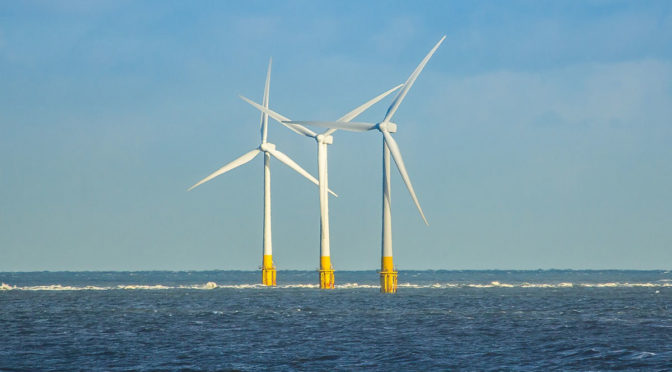The US East Coast is leading the nation’s charge toward developing an offshore wind industry, and while the country only has 30 MW of offshore wind capacity installed currently, if goals are met and announced projects are built, the East Coast could have nearly 9 GW of offshore wind capacity by the 2030s.
The US has a long way to go in closing the gap with Europe in terms of offshore wind capacity, but with several East Coast states committing to achieve aggressive offshore wind development goals, the country could make considerable progress over the next decade.
Europe had nearly 16 GW of total installed offshore wind capacity at the end of 2017, according to trade group Wind Europe, compared with just one operating facility in the US — Deepwater Wind’s 30-MW Block Island Wind Farm in Rhode Island.
New York, New Jersey and Massachusetts are leading the way when it comes to setting offshore wind development goals. New York has a target to receive 2.4 GW of offshore wind power by 2030 and plans to issue requests for proposals for 800 MW in fourth-quarter 2018.
Not to be outdone, New Jersey has a goal of 3.5 GW of offshore wind generation by 2030. The state’s Board of Public Utilities Wednesday accepted an application from EDF Renewables and Fishermen’s Energy for the small-scale 25-MW Nautilus Offshore Wind project that would be located off the Atlantic City coast and could be generating power by 2021. Building a smaller project first has been touted by the companies as a way to kick start New Jersey’s offshore wind industry.
Massachusetts has mandated the state’s electric distribution companies procure 1,600 MW of offshore wind power by the end of July 2027. In May, the 800-MW Vineyard Wind project was selected through a competitive bidding process. The project, which is being developed as part of a joint venture between Avangrid Renewables and Copenhagen Infrastructure Partners, could be operational by 2021.
DEVELOPMENT HUB RACE
States up and down the East Coast are vying to develop a regional offshore wind development hub that would create jobs, stimulate local economic activity and ultimately be able to support offshore wind projects in other states.
Interestingly, however, New York Public Service Commissioner Diane Burman pushed back on that idea at a commission meeting in July, questioning whether it makes sense for the state to be a first mover in offshore wind development. “I am somewhat concerned we are going full steam ahead because we want to win the race, but are we carefully looking at important questions around costs?” Burman asked.
First adopters may actually end up spending more money than “if we took a pause and waited,” she said. The New York Energy Research and Development Authority estimated a typical residential customer’s bill would rise by less than 76 cents/month for the first 400 MW of developed capacity.
VARYING MARKET IMPACTS
The impacts on power markets will depend on actual capacity added relative to the size of the coastal markets, according to S&P Global Platts Analytics, and the impact likely will be more limited in the near to medium term.
Coastal regions often import power from more inland generation, leaving the new wind power to displace such imports, assuming the needed infrastructure enhancements to facilitate the offshore power materializes as planned. Offshore wind’s generation profile can be more complementary with solar power than onshore wind, which can provide better coverage of demand peaks.
Platts Analytics estimates that New York, Massachusetts, Maryland, Connecticut and Rhode Island could have 2.4 GW of installed offshore wind capacity by 2025. By 2030, those states, plus New Jersey, Virginia and North Carolina, could have 8.8 GW of installed offshore wind power capacity.
CONNECTICUT
In June, Connecticut officials chose Deepwater Wind to supply 200 MW from the Revolution Wind project. Connecticut’s authority under Public Act 17-144 for offshore wind is limited to 3% of the state’s electric distribution companies’ total electric load, and Connecticut has selected that full amount.
MARYLAND
Italy’s US Wind and Skipjack Offshore Wind were awarded offshore wind renewable energy credits at a levalized price of $131.93/MWh for a term of 20 years, beginning in January 2021 for US Wind and 2023 for Skipjack, according to the Maryland Public Service Commission. US Wind could supply 248 MW and Skipjack could provide 120 MW.
VIRGINIA
Dominion Energy Virginia and Denmark-based Orsted in August filed with Virginia’s State Corporation Commission for approval to build two 6-MW turbines and grid infrastructure needed to connect the Coastal Virginia Offshore Wind Project to the coast.
NORTH CAROLINA
In March 2017, the Bureau of Ocean Energy Management held a competitive lease sale for the Kitty Hawk Wind Energy Area, offshore North Carolina. Avangrid Renewables, which bid about $9.067 million, was the winner of lease OCS-A 0508, covering 122,405 acres. No state-level wind targets have been set in North Carolina. Avangrid has not yet determined the eventual size of the wind farm that could be installed in the leased area off Kitty Hawk.
— Jared Anderson, [email protected]
— Edited by Valarie Jackson, [email protected]


